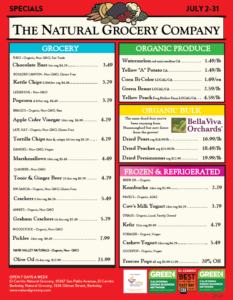“The Annex Sessions” Wednesday, July 31, 2024, 6-8:30pm will continue our music series held at El Cerrito Natural Grocery Company Prepared Food Annex (The Annex)
Julio Bravo & Friends
featuring: Julio Bravo – vocals
with special guests:
Jose Soto – piano & guitar
David Pinto – bass guitar
Alberto Palomino – percussion
Raul Ramirez – percussion
and possibly others!
Salsa from Peru and beyond!
ARRIBA PERÚ 🇵🇪 FELIZ 28!!
The Natural Grocery Company is proud to present this series in partnership with SunJams and Javier Navarrette Music Productions.
SunJams is committed to funding children’s music education in underserved public elementary schools. Your donation will help support this ongoing program.
All of the proceeds will go directly to our network of local musicians, each of whom have been severely impacted by the lack of events during the COVID-19 pandemic.
Whether you donate $10, $100, or $1000 – any amount helps and will allow us to keep bringing music to our community! As always, your donation to SunJams 501(c)3 may qualify as tax exempt.
Javier Navarrette Music Productions continues to bring live music to several venues around the Bay Area. Javier has been a professional musician and music educator in the Oakland Unified School District for the past 20 years. Over the past few years Navarrette has produced outdoors events that have proven instrumental in enabling musicians to deal with some of the fallout of the pandemic and shutdown that followed.
COVID RELATED SAFETY MEASURES
Please be safe. Feel free to wear a mask if you prefer.
TICKETS
Tickets are NOT required for this venue, you can simply come in, order food and beverages at the Annex counter and pay at the registers.












